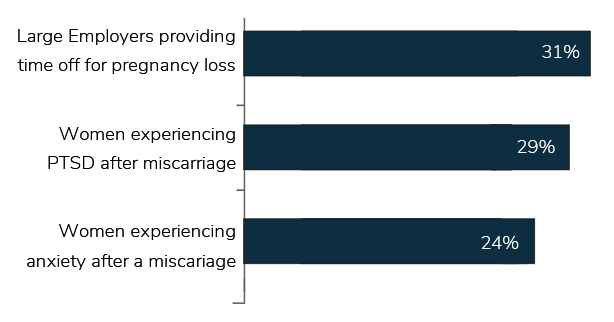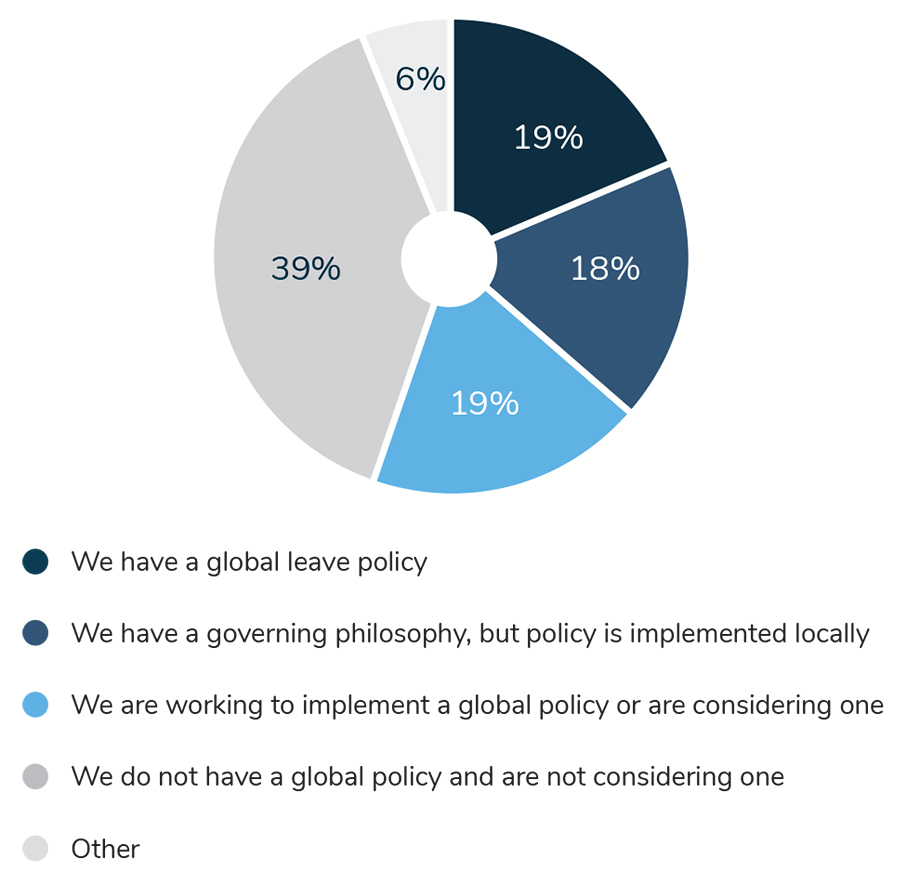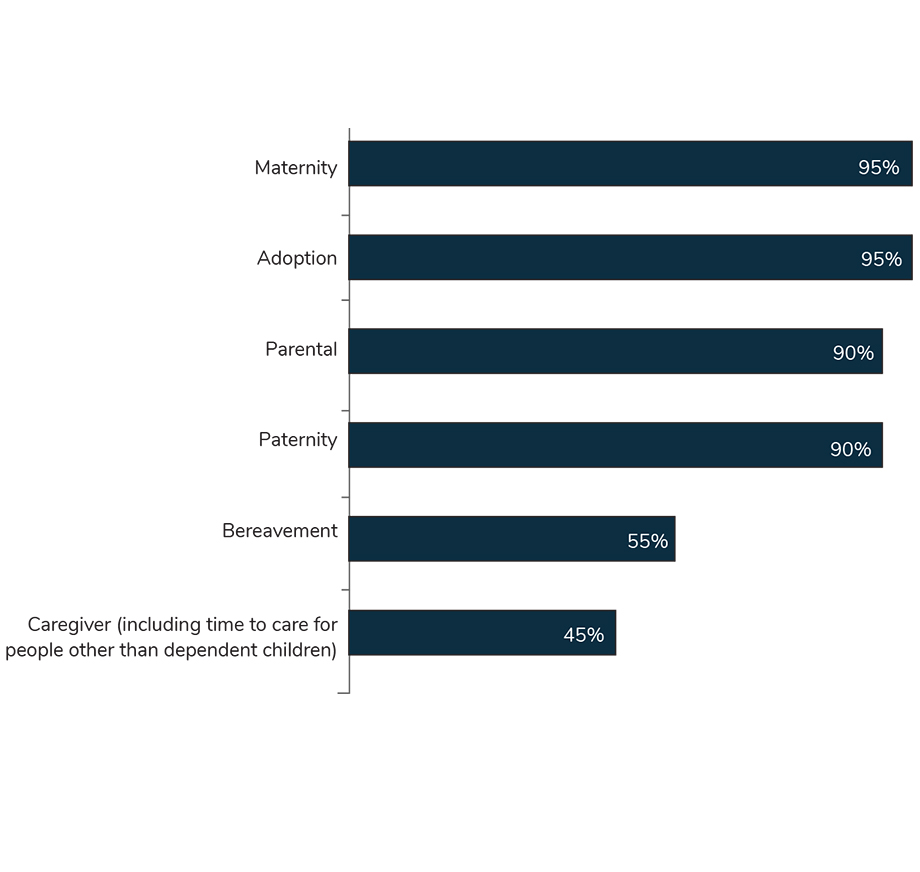May 21, 2020
Bereavement leave is a common benefit among large employers that provides employees with time off when someone close to them passes away. According to the 2020 Large Employers’ Leave Strategy and Transformation Survey, 100% of large employers offer paid bereavement leave in the U.S., and among employers with a global leave policy, 55% include bereavement leave.
In 2020, large employers typically offer five days of paid bereavement leave, but leading employers aim to set a new trend in motion by expanding bereavement leave policies in their duration and scope and integrating a suite of benefits and services beyond leave that more robustly supports grieving employees and their families.
This article describes the business case for bereavement leave and seven considerations for designing a modern bereavement leave policy.
Business Case for Bereavement Leave
Large employers recognize that bereavement leave is the right thing to do for employees experiencing a difficult life moment and for the business.
Employee Well-being
Losing a loved one is traumatic and can take a toll on one’s mental health. Employees may experience a variety of emotions, from denial and disbelief to sadness, anger and guilt. Bereavement leave is a way to acknowledge an employee’s loss and provide needed time to cope.
Employer Brand
Employers with bereavement leave, and even better, generous bereavement leave, are regarded as caring. Increasingly, how companies treat employees matters for attracting, retaining and engaging a talented workforce, and for building rapport with customers, who want to do business with companies that care about people, the planet and purpose.
Employee Loyalty
Bereavement leave is an opportunity for employers to show compassion. Offered with empathy and kindness, bereavement leave can strengthen relationships with employees. However, a lack of bereavement leave or any difficulty with the bereavement leave experience is likely to cause a rift between employees and the company.
Performance
Providing employees with time to mourn after the loss of a loved one can prevent distractions and accidents at work in the short term and foster productivity in the long run. Bereavement leave gives employees needed space to focus on what matters—whether that’s making memorial arrangements, starting to emotionally heal or being there for their families.
Drive change with our Leave Optimization Forum.
Learn More ![]()
Seven Considerations for Designing a Modern Bereavement Leave Policy
Just as grieving isn’t a one-size-fits-all process, bereavement leave policies vary based on other available leave and benefits, business priorities and the organization’s culture. Here are some key considerations for businesses when creating or revamping bereavement leave policies.
Determine the Right Amount of Leave
Employers must strike a balance among providing paid time away to support employee well-being, ensuring that benefits are comparable to other employers and mitigating costs. While large employers commonly offer 5 days of bereavement leave in the U.S., leading employers have recently extended the duration of bereavement leave available to provide employees and their families with more time to grieve. For example, Facebook extended its leave to 20 days for immediate family members and 10 days for an extended family member in 2017, and when General Mills overhauled its leave benefits in 2019, it boosted the bereavement leave benefit to 4 weeks for the loss of an immediate family member. Other employers have chosen to grant extra days of leave to employees who are responsible for arrangements or must travel to funeral or memorial services.
Qualifying Relationships: One Policy May Not Fit All
Bereavement leave can be the same duration regardless of the employee’s relationship to the deceased, or employers can specify the relationships that are covered and offer different amounts of time away for different relationships (e.g., more time off for an immediate family member than for an extended family member). A variety of relationships can be covered by bereavement leave policies:
- Spouses and domestic partners;
- Children, stepchildren and foster children who live with the employee;
- Parents, stepparents and legal guardians;
- Grandparents and step-grandparents;
- Great-grandparents;
- Grandchildren and step-grandchildren;
- Siblings and stepsiblings;
- Aunts and uncles;
- Nieces and nephews;
- Cousins;
- Parents-in-law, grandparents-in-law, siblings-in law, children-in-law;
- Close friends;
- Co-workers;
- Pregnancy loss (e.g., stillbirth or miscarriage); and
- Any other individuals as required by law.
To be as inclusive as possible, employers may provide bereavement leave for those with family-like relationships; this practice can ensure that the policy acknowledges the grief of employees who grew up with extended families (e.g., an employee who was raised by their grandparents may have a closer relationship with them than with their birth parents) or have a chosen family, common in the LGBTQ community).
Specify Eligibility for Bereavement Leave
While some employers offer bereavement leave to all employees, others specify which employee populations are eligible. When developing or reviewing bereavement leave policies, employers should consider if extending eligibility beyond benefit-eligible employees is appropriate and how it should be done. Bereavement leave may be a particularly important benefit for employees who do not have access to other types of paid leave. If bereavement leave is not extended to all employees, consider if changes are needed to the attendance policy to ensure that employees are not penalized for arranging and/or attending memorial services.
Provide Leave for Pregnancy Loss
After a miscarriage, 29% of women experience posttraumatic stress disorder (PTSD), 24% experience anxiety and 11% experience moderate to severe depression. While providing paid time off after a pregnancy loss is a meaningful way to support the physical and emotional health of employees, it is far from the norm today. According to the Business Group’s 2020 Large Employers’ Leave Strategy and Transformation Survey, 31% of large employers provide time off for pregnancy loss in 2020, and only 7% are considering doing so in 2021/2022. Employers may create a separate leave to cover miscarriages and stillbirths, or they can choose to include pregnancy losses in their bereavement leave policies. Like other family leaves, employers should be inclusive of both moms and dads when providing leave related to pregnancy loss and consider how the new leave opportunity will intersect with other benefits (e.g., STD, PTO or sick leave).

Determine How and When Bereavement Leave Is Used
While most bereavement leave is used immediately following the loss of a loved one or in conjunction with memorial services, employers can set parameters for how and when the time away is used. Many large employers allow for leave to be used intermittently; administering bereavement leave in this way can empower employees to take time as they need it to cope and heal. For example, an employee may choose to save some leave for days of significance throughout the year, such as birthdays or anniversaries. Employers may also establish a time period within which bereavement leave must be used, such as 1 year after a loss.
COVID-19 Consideration: If employers have a deadline for bereavement leave use, they should consider if an extension is appropriate due to travel restrictions and other challenges associated with COVID-19. For other COVID-19-specific considerations, review Grieving and Bereavement in the Time of Coronavirus.
Create a Global Minimum Standard
For multinational employers, a global leave minimum standard can harmonize policies company-wide, establish global governance and oversight, ensure a consistent employee experience and reduce administrative complexity. According to the 2020 Large Employers’ Leave Strategy and Transformation Survey, 19% of large employers with a global presence have a global leave policy and another 19% are working to or are considering implementing a policy. Of those with a global leave policy, 55% include bereavement leave.


When employers are creating a global minimum standard for bereavement leave or incorporating bereavement leave into an existing standard, it is recommended that they create an inventory of current bereavement leave policies and practices, including those created within the company (both formal and informal) and statutory requirements, to inform policy development, and receive leadership buy-in before implementing the policy at the local level. And because every culture has its own beliefs, rituals and norms related to bereavement and grief, it is critical that corporate HR talk with local HR teams about what is and is not appropriate before making assumptions or global policies. For more information on global benefits and strategy, visit the Business Group’s Global webpage.
Develop Guardrails to Ensure Manager Discretion Is Compassionate and Fair
Managers can play a big role in acknowledging grief and ensuring that employees have the support they need. Because every situation is unique, many companies build room for manager discretion into their policies. For example, managers may be allowed to grant leave even if the employee’s relationship with the deceased is not specified in the policy, such as an uncle who’s like a father or an ex-spouse.
Before an employee goes on bereavement leave, their manager should reassure them that their work will be covered, so they do not feel pressure to come back before they are ready. Managers can also use discretion to touch base with the employee during the leave; the communication should focus solely on recognizing the employee’s loss and grief and extending support. When the employee returns, it’s the managers responsibility to set clear, reasonable expectations and create a culture of compassion.
Beyond leave, managers can demonstrate they care by extending flexible work arrangements, communicating other available benefits and services and acknowledging the employee’s grief. For more information on supporting employees through grief, review the Think Beyond Bereavement Leave section below; for pandemic-specific information, go to Grieving and Bereavement in the Time of Coronavirus.
Think Beyond Bereavement Leave
Time away from work after the loss of loved ones gives employees needed space to start healing, but leave alone is not enough. Employers should consider other benefits, services and communication practices that can be integrated with bereavement leave to support employees robustly. Here are a few ideas:
Communication and Acknowledgement
When an employee loses a loved one, it is important for managers and colleagues to acknowledge the grief they’re experiencing and extend sympathy through simple acts, such as verbally expressing care and concern (e.g., “I’m thinking of you”), sending a note or a gift or offering to help with specific tasks (e.g., bringing over a meal, running an errand, etc.). Employers may consider training managers and employees on how to best respond with empathy and patience when a team member is grieving, including what is helpful to say and what may not be. Managers should always check first with the employee before sharing any personal information and remember that each individual’s grief and recovery journey is different.
Flexible Work Arrangements
Flexibilities can help ease employees back into the workplace while they navigate their new normal. For example, flexible work hours may be especially important for a widow who is figuring out new routines for themselves and their children. Telework can help employees get back to work and remember the sense of purpose that work provides in the comforts of their home. Other employees may find a reduced work schedule (e.g., 30 hours/week) is best as they return to work, giving them a few extra hours to manage responsibilities in their personal life and take care of themselves.
Emotional Support
Ensuring that employees are aware of available resources after the death of a loved one and reducing barriers to use, such as stigma, is critical to helping grieving employees.
Financial Support
The death of a loved one can bring unexpected financial challenges. Again, communication of available resources, such as financial counseling—offered by 75% of large employers in 2020—is key. Employee relief funds can offer immediate aid by making financial assistance available for funeral expenses, medical bills and other hardships. Employers can also help all employees plan ahead by offering life insurance benefits, will preparation services and financial planning.
- 1 | Farren J, Jalmbrant M, Falconieri N, Mitchell-Jones N, Bobdiwala S, Al-Memar M, Tapp S, Van Calster B, Wynants L, Timmerman D, Bourne T. Posttraumatic stress, anxiety and depression following miscarriage and ectopic pregnancy: a multicenter, prospective, cohort study. American Journal of Obstetrics & Gynecology. December 2019; 222(4):367.e1-22.
More Topics
Articles & Guides
This content is for members only. Already a member?
Login
![]()
